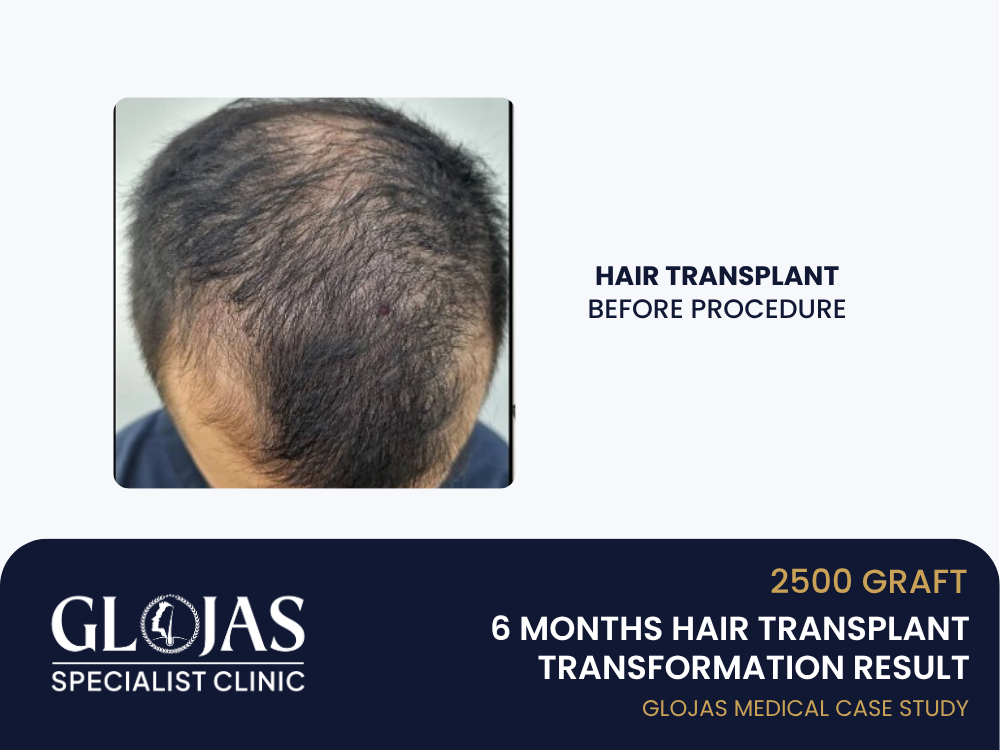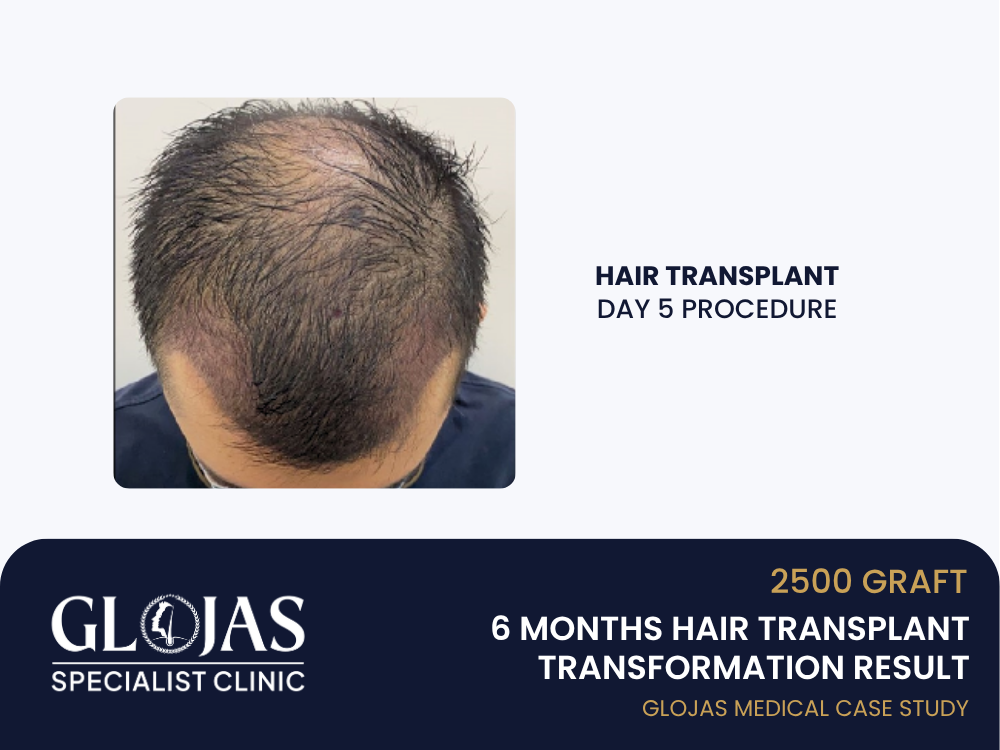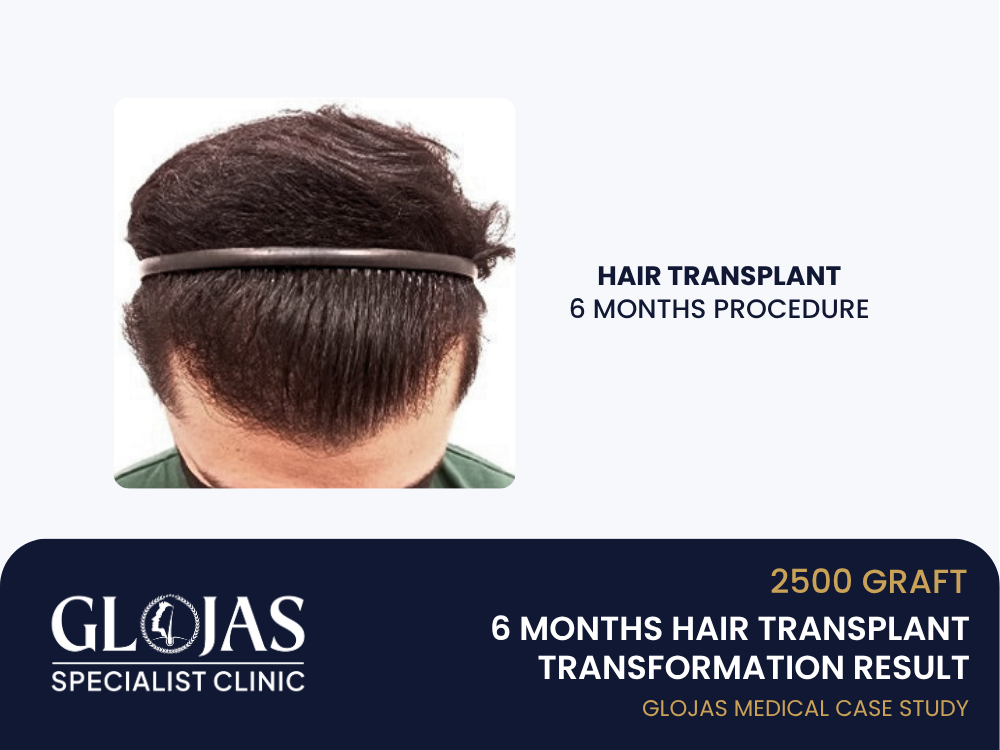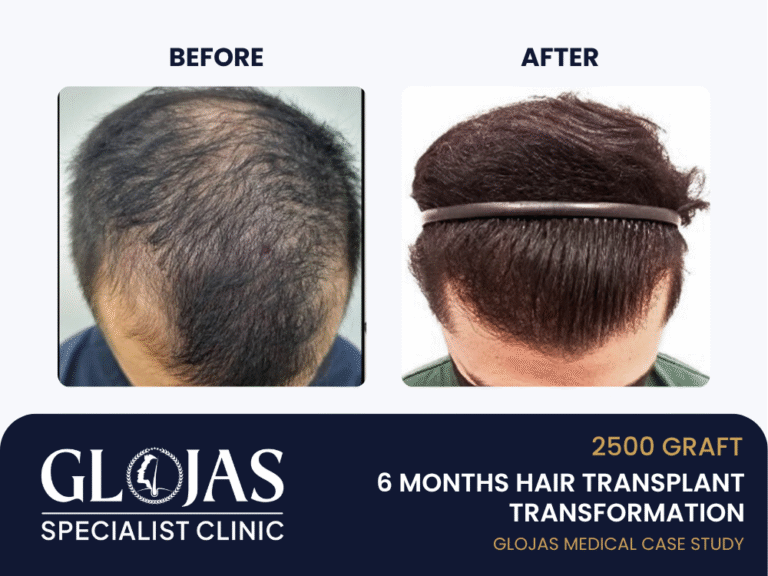Hair loss at the vertex (crown) is one of the most difficult areas to treat, often progressing with age and affecting the confidence of many men. This case study follows a 38-year-old male who underwent a SMART™ FUE Hair Transplant to restore density and coverage in the crown region due to Norwood 4 hair loss.
After just 6 months, his results were already visibly impressive, providing physical transformation and renewed self-esteem.
Patient Profile
Name: Mr. D (identity anonymized)
Age: 38
Hair Loss Pattern: Norwood 4 – Significant thinning at the crown (vertex) and mild recession at the hairline
Hair Type: Wavy, medium thickness
Scalp Condition: Normal, healthy blood supply
Goal: Restore coverage to the crown and blend with existing hair for natural density
Initial Concerns & Motivation
Mr. D had been experiencing gradual thinning at the crown for over 5 years. It became more noticeable in photos and under strong lighting, which led him to cover the area with styling products or hats.
He had tried shampoos and supplements with minimal success and finally decided to opt for a permanent solution through SMART™ FUE hair transplant.
Why SMART™ FUE?
SMART™ FUE (Scalp Micro-Advanced Restoration Technique) is a next-generation method of Follicular Unit Extraction (FUE) that delivers:
Precision harvesting of grafts with minimal trauma
Higher graft survival rate (up to 95%)
Natural angling and placement — critical for crown whorl patterns
No linear scarring
Faster recovery and minimal discomfort
Crown hair transplant requires a spiral pattern and careful density planning, making SMART™ FUE the ideal method for this case.
Consultation & Graft Planning – Hair Transplant
During the consultation, a digital trichoscopy and scalp assessment were performed. The crown has a clear thinning with exposed scalp and a disrupted whorl. His donor area, the back and sides of the scalp, showed strong density, ideal for extraction.
Graft Distribution Plan:
Total grafts: 2,500
Crown/vertex: 2,000 grafts
Mid-scalp blending: 500 grafts
The aim was to achieve a natural spiral pattern that mimicked his original hair flow, while gradually blending into the surrounding thinning zones.
Procedure Day Overview

Duration: Approx. 7 hours
Anaesthesia: Local
Punch Tool: 0.8 mm micro-punch
Implantation Tool: Sapphire blade for recipient site creation
Procedure Steps:
Hairline and crown design marked
Local anesthesia administered
2,500 grafts extracted using SMART™ FUE
Follicles sorted (single, double, triple)
Recipient sites are prepared following the crown’s natural spiral
Grafts implanted with careful angling
Mr. D reported minimal discomfort and resumed light activity the next day.
Recovery & Growth Timeline

Days 1–3: Mild swelling and redness in the crown
Week 1: Tiny scabs formed; patient followed post-op cleaning protocol
Week 3: Shedding of transplanted hairs (shock loss phase)
Month 3: New hair follicles began sprouting
Months 4–5: Increased density and volume
Month 6: Visible coverage and whorl pattern formation
6-Month Results

Though full results typically take 9–12 months, Mr. D already had a dramatic improvement in crown density at the 6-month mark, and no longer felt the need to cover his head.
| Area | Before | 6 Months After |
|---|---|---|
| Crown | Large bald spot, exposed scalp | 70% coverage restored with visible volume |
| Hairline | Mild recession, stable | Blended smoothly with the crown |
| Confidence | Reluctant in photos, wore hats | Comfortable with short hairstyles |
| Styling Needs | Thickening sprays daily | None – natural hair volume returned |
Patient Feedback
“The crown was always the hardest part to hide. Now I forget I even had that bald spot. The SMART™ FUE hair transplant was the best decision I’ve made for myself.”
Mr. D was especially impressed with the natural whorl created, which matched his previous growth pattern almost identically.
Follow-Up & Maintenance
No oral medication prescribed, but the patient opted for DHT-blocking shampoo
PRP therapy is suggested every 6 months to support long-term follicle health
Next follow-up scheduled for Month 12 to assess full maturity of grafts
5 Frequently Asked Questions (FAQ)
1. Is 6 months enough to see results?
Partial results are visible at 6 months, typically around 60–70% of the final density. Full results are seen by 9–12 months.
2. Can transplanted hair grow in a spiral like the crown?
Yes. With SMART™ FUE, surgeons recreate the natural whorl pattern of the crown by carefully angling each follicle during implantation.
3. Is the crown harder to treat than the front?
Yes, the crown has unique growth patterns and usually requires more grafts to achieve full coverage. But with proper technique, results can be excellent.
4. Will I need more grafts in the future?
If hair loss progresses, some patients opt for a touch-up session in 2–5 years. However, with stable hair loss and a good donor supply, one session may suffice.
5. Is SMART™ FUE better than traditional FUE?
✅ Yes. SMART FUE offers higher precision, a better survival rate, and less trauma, especially in complex areas like the crown.
Conclusion
This case demonstrates how 2,500 grafts with SMART™ FUE can deliver transformative results in only 6 months, especially for those suffering from Norwood 4 vertex hair loss.
The natural swirl pattern, density, and confidence regained by Mr. D are a testament to what’s possible with modern hair restoration techniques.
If you’ve been hiding your bald spot or feel limited by thinning in the crown, SMART™ FUE could be your answer — and this case proves that meaningful results don’t have to take a full year to appear.

